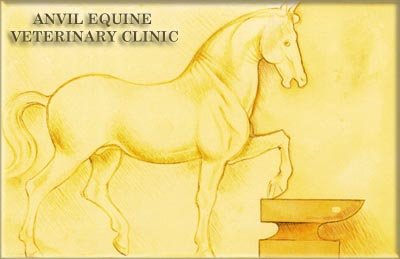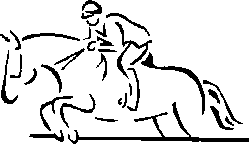A Veterinary Review of
Common Injuries in the Sport Horse
Dr David Platt BVSc.,
PhD., DEO., FRCVS
Consultant equine orthopaedic surgeon
Many people who keep horses will know the thrills
involved in competing with their mounts in endurance or in the
show jumping, dressage or eventing arena. Anyone who is involved
with competition horses at any level will have at one time or
another experienced the frustrations of having their horse suffer
from lameness or other debilitating injury. It is particularly
pertinent to discuss these issues this month in view of the
hard ground at the present time.
Treating sports horse injuries is a specialised
area of equine veterinary work since many of the underlying
causes of lameness are difficult to accurately locate and treat.
Understanding the nature of sports injuries requires the rider
to appreciate the forces that can be involved when a fit horse
weighing up to 600Kg performs the technical and athletic activities
we demand. The power involved in the take-off and the forces
of landing during show jumping or the tremendous energy involved
in the collected paces of dressage are good examples. The animals
conformation and action in addition to the course terrain can
all play a part in determining the concussion that has to be
absorbed.
Foot Problems
The tremendous impact forces incurred during fast work can
result in a variety of injuries. To try to minimise the risks
of foot problems it is vital that the horse is well shod and
that the shoes are refitted every four to five weeks. The farrier
must ensure that the foot is well balanced with a straight foot
pastern axis and that the shoe is fitted so that it has no contact
with the sole, especially at the seat of corn. This will allow
all the concussion to be transferred to the hoof wall and will
help to prevent bruising. Bruising on the sole at the junction
between the hoof wall at the heel and the bar is termed a corn
and is a common cause of foot lameness. Hoof cracks can occur
at a number of different locations and can be very frustrating
to the owner and rider. Treatment is usually achieved by stabilising
the crack using fibreglass adhesive patches applied to the hoof
wall in combination to special shoes that have a clip on either
side of the crack.
Joint Sprains
Soft tissue injuries to the lining can result in painful
tense swellings within equine joints. The most susceptible joints
are the coffin and fetlock joints of the front limbs but other
joints, such as the large mobile joint of the hock can also
be affected. The swelling frequently appears very rapidly following
strenuous exercise. Such inflammation in a joint can be secondary
to small chip fractures and it is advisable to seek advice from
your veterinary surgeon about treatment, which may involve
X-raying the affected area to determine if a fracture is involved.
First aid for such injuries involves ice wrapping the affected
joint for 30 - 60 minutes before applying a snug well padded
stable bandage. There are many proprietary ice bandages available
but if you do not have one available a simple solution is to
bandage a pack of frozen peas into position around the affected
joint. If the sprain is mild, with no bony damage, it may only
be necessary to rest the horse for a short period before continuing
with light work. If more severe, then a period of enforced rest
combined with anti-inflammatory medication followed by controlled
handwalking exercise may be required before the lameness resolves.
Bony chip fractures inside the joint usually have to be removed
using keyhole surgery.
Tendon Injuries
There are four main tendinous structures in the lower limb
of the horse that are frequently injured. The superficial digital
flexor tendon is the most commonly damaged structure because
during normal fast work it is functioning close to its maximum
strength. The other structures that can be damaged are the deep
digital flexor tendon, the inferior check ligament which is
located just below the back of the knee and the suspensory ligament.
Tendinous structures are more prone to injury during high speed
training but can occur at other times during schooling or competition.
When a tendon becomes injured the leg will feel thickened and
have an increased surface temperature around the area of damage.
Veterinary attention should be sought immediately
if a tendon injury is suspected because it is vital that the
inflammatory process within the tendon is suppressed.
Up to 50% of the damage in a strained tendon occurs after the
injury and is the result of the inflammation which develops
during the first 12 hours in response to the strain. Modern
veterinary medicine can help to dramatically reduce this extra
damage and therefore minimise the fibre disruption that has
to repair. Ultrasound scanning of the tendon structures is the
only way to fully assess the extent of the damage and should
be done at a very early stage. Modern medications, that can
be injected around the tendon or in some cases into the recently
damaged tendon, can have dramatic effects on reducing the inflammation.
Bandaging which provides counter pressure to reduce tissue swelling
is also vital and is combined with strict box rest in the early
stages after injury. Recuperation programs involving prolonged
controlled exercise instead of unrestricted pasture rest, with
ultrasound monitoring, are also revolutionising the quality
of tendon repair that can be achieved. Many horses with mild
to moderate tendon damage can often be return to their former
levels of exercise if the rehabilitation is carefully undertaken.
Fractures
The very nature of the work that we ask horses to perform
carries risk of injuries from collision with fences or other
obstacles. Fractures are, thankfully, a relatively rare consequence
of such injuries but are seen occasionally. The term fracture
means any damage to a bone in the skeleton which can range from
tiny fragments inside a joint to complete disruption of a major
long bone such as the cannon bone. Any severe lameness associated
with joint swelling should be investigated by X-ray to determine
if a fracture fragment is involved.
Small fragments inside a joint are most easily
removed by keyhole surgery (arthroscopy). This technique does
very little damage to the joint capsule and the horses are often
back in work within 8 - 12 weeks of surgery. Larger fractures
involving major long bones are a much greater challenge and
require fixation with bone plates to reconstruct the tissues.
Not all cases of equine fractures can be repaired but with advances
in modern surgical techniques, it is now possible to successfully
treat many of the common fractures.
The demands on sports horses is enormous and
it remains the responsibility of the veterinary surgeon to help
the owner and rider keep their horse in the best possible health
so that it may be used to compete. Modern diagnostic equipment
can help to localise the site of pain and advances in medication
and surgical techniques have made treatment of many injuries
far more successful.
Cover clients based in Surrey, Sussex, Kent, Berkshire and East
Hampshire 24 hours a day – 365 days a year. The Anvil team currently
consists of 3 Veterinary surgeons – Alastair MacVicar (Principal),
Mike Barrott and Liz Brown, supported by Dr David Platt who carries
out our major surgery. Anvil also have 3 equine veterinary nurses,
and an office support team of 3. The Clinic consists of a theatre
and recovery room, an X-ray area with treatment facilities and
stocks for the more difficult horses and procedures. With these
and a wide range of modern equipment the clinic is now prepared
for a wide range of diagnostic and treatment techniques.

